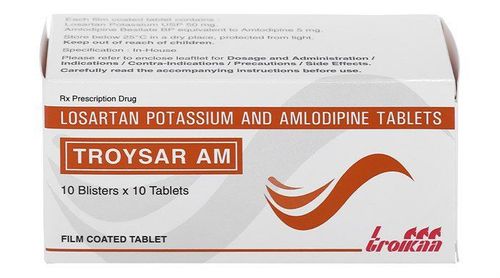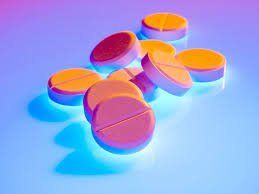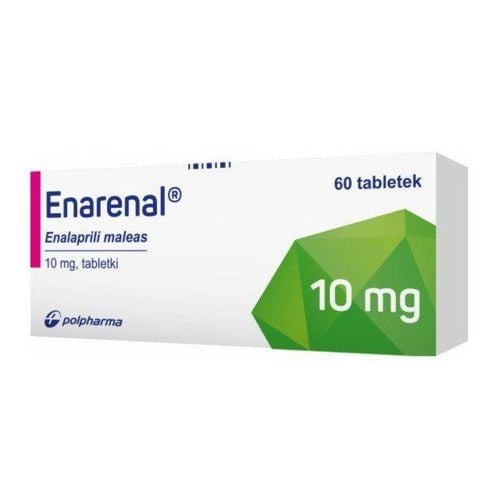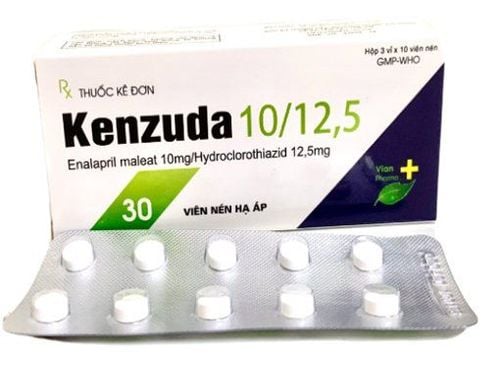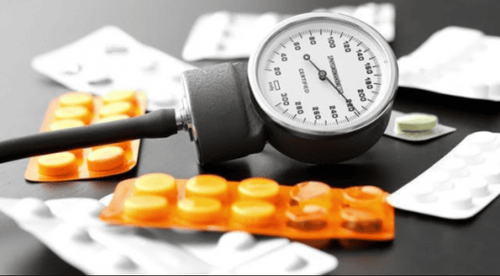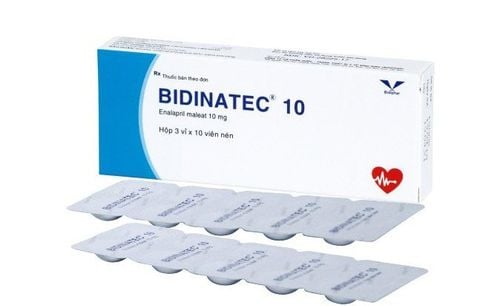This is an automatically translated article.
Ebitac forte is a drug indicated for the treatment of high blood pressure, containing two main ingredients, Enalapril and Hydrochlorothiazide. The following article provides you with information about the uses, dosage and precautions when using Ebitac forte.1. What are the uses of Ebitac forte?
Ebitac forte is a drug indicated for the treatment of high blood pressure, containing two main ingredients, Enalapril with a strength of 20mg and Hydrochlorothiazid with a content of 12.5mg. Enalapril Enalapril is an angiotensin-converting enzyme inhibitor, the metabolite of enalapril is enalaprilat, which has an effect after oral administration.Enalapril reduces blood pressure in people with normal blood pressure and hypertension. Enalapril has a beneficial effect on hemodynamics in patients with congestive heart failure, mainly due to inhibition of the renin - angiotensin - aldosterone system. Enalapril prevents angiotensin I from being converted to angiotensin II (a potent vasoconstrictor) by inhibiting angiotensin-converting enzyme. Enalapril reduces serum aldosterone thereby reducing sodium retention, increases the kallikrein-kinin vasodilatation, alters prostanoid metabolism and inhibits the sympathetic nervous system.
Angiotensin-converting enzyme plays an important role in kinin breakdown, so Enalapril also inhibits bradykinin breakdown. Bradykinin is a potent vasodilator, and these two effects of Enalapril explain why there is no proportional relationship between renin concentrations and clinical response to Enalapril treatment.
In hypertensive patients, Enalapril reduces blood pressure by reducing total peripheral resistance and without increasing or slightly increasing heart rate, cardiac output, or systolic flow. Enalapril causes dilation of the arteries and possibly veins. Enalapril reduces diastolic and systolic blood pressure by about 10-15% in both the lying and sitting positions. Orthostatic hypotension and tachycardia are uncommon with Enalapril, but are more common in patients with hyponatremia or hypovolemia. In patients with congestive heart failure, Enalapril, often combined with diuretics and cardiac glycosides, has been shown to reduce total peripheral resistance, heart size, pulmonary artery occlusion pressure, and mean arterial pressure. and right atrial pressure. Cardiac output, cardiac index, systolic volume, and exercise tolerance increased. Left ventricular hypertrophy decreased after 2-3 months of treatment with angiotensin-converting enzyme inhibitors, because angiotensin II is a potent stimulator of myocardial growth.
Renal blood flow may be increased, but glomerular filtration rate is usually unchanged during treatment with Enalapril. Blood urea nitrogen (BUN) and serum creatinine may be increased during long-term enalapril treatment, which is more common in patients with pre-existing kidney damage or in patients with renal vascular hypertension. In addition, renal function may deteriorate markedly during angiotensin-converting enzyme inhibitor therapy in patients with pre-existing severe renal impairment.
In patients with diabetes, Enalapril helps to reduce protein - urinary excretion. Enalapril has been shown to increase insulin sensitivity in hypertensive patients with or without diabetes. Enalapril did not reduce lipid metabolism to any extent. Hydrochlorothiazide Hydrochlorothiazide and thiazide diuretics increase water and sodium chloride excretion by inhibiting the reabsorption of sodium and chloride ions in the distal tubule. The excretion of potassium and magnesium is also increased but calcium is decreased.
Hydrochlorothiazide reduces carbonic anhydrase activity, thereby increasing bicarbonate excretion, but this effect is usually insignificant compared to the effect of Cl- excretion and does not alter urine pH. Thiazide diuretics have a moderate diuretic effect, since about 90% of sodium ions have been reabsorbed before reaching the distal tubule, which is the main site of action of thiazide diuretics. Hydrochlorothiazide has a hypotensive effect, probably due to a decrease in plasma volume and extracellular fluid associated with urinary sodium excretion. Later in the course of taking Hydrochlorothiazide, the antihypertensive effect depends on the decrease in peripheral resistance, through the gradual adaptation of blood vessels to the decrease in Na + concentration. Therefore, the antihypertensive effect of Hydrochlorothiazide manifests slowly after 1-2 weeks of use, while the diuretic effect occurs rapidly after a few hours. Hydrochlorothiazide enhances the effect of other antihypertensive agents.
2. Indications and contraindications of Ebitac forte
2.1. Indications Ebitac forte is indicated in the treatment of hypertension.
2.2. Contraindications The use of Ebitac forte is contraindicated in the following cases:
Allergy or hypersensitivity to Enalapril maleate, Hydrochlorothiazide, or any of the excipients of Ebitac forte. Allergy to drugs derived from sulfonamides. Severe renal impairment (creatinine clearance <30ml/min) Anuria. Porphyria metabolism disorder. Gout. Severe diabetes. History of angioedema associated with angiotensin-converting enzyme inhibitor therapy. Idiopathic or hereditary angioedema. Pregnant women in the 2nd and 3rd trimesters (from the 4th month onwards). Renal artery stenosis.
3. How to take Ebitac forte
3.1. Dosage Ebitac forte is taken orally. Dosage of Ebitac forte is determined by the dose used with the component enalapril maleate. The dose of the drug must be adjusted according to the individual patient.
Adults: Hypertension: The usual dose is 1 tablet / time x 1 time / day. If necessary, the dose can be increased to 2 tablets once a day. Concomitant diuretic therapy: Symptomatic hypotension may occur after the initial dose of Ebitac forte. Therefore, diuretic therapy should be discontinued for 2 to 3 days prior to initiating treatment with Ebitac forte. Dosage in renal impairment: Hydrochlorothiazide is not suitable for patients with renal impairment and is not effective when creatinine clearance is less than 30 ml/min. In patients with creatinine clearance > 30 ml/min and < 80 ml/min, Ebitac forte should be used only after titration of the drug components. Adjust the dose of Ebitac forte especially when used in combination with other antihypertensive agents. If the desired therapeutic effect is not achieved within 4 weeks, consider increasing the dose or adding another antihypertensive agent. Elderly: Clinical studies have shown that the efficacy and tolerability of Enalapril and Hydrochlorothiazide when co-administered in the elderly is similar to that in young hypertensive patients. Children: The efficacy and safety of Ebitac forte use in children have not been established. Consult your doctor before using the drug. 3.2. Overdosage of Ebitac forte and Management There is limited data on overdosage with Enalapril in humans. The most common symptom of an Enalapril overdose is severe hypotension. When an overdose of Enalapril occurs, treatment should be discontinued and the patient closely monitored. Besides, applying supportive and symptomatic treatment measures such as induction of vomiting, gastric lavage, intravenous infusion of plasma and sodium chloride to help maintain blood pressure and treat electrolyte imbalances. Enalapril can be removed from the circulation by hemodialysis.
Symptoms of an overdose of Hydrochlorothiazide are mainly fluid and electrolyte disturbances due to excessive diuresis. If taken concomitantly with Digitalis, hypokalemia may increase the risk of cardiac arrhythmias.
4. Undesirable effects when using Ebitac forte
Adverse effects are usually mild and transient, but about 3% to 6% of people taking Ebitac forte have to stop treatment. Severe symptomatic hypotension has been reported after the first dose of Ebitac forte and in up to 2 to 3% of people in clinical trials discontinued treatment, particularly in patients with hyponatremia, heart failure, and heart failure. and the elderly are being treated concurrently with diuretics.
Patients with congestive heart failure often present with worsening renal function, symptomatic hypotension and increased serum potassium levels, especially during the initial period of Enalapril in patients receiving concomitant diuretics. Worsening renal function (transient elevation of serum urea and creatinine) has occurred in approximately 20% of hypertensive patients with renal disease, particularly in patients with bilateral renal artery stenosis or renal artery stenosis when only have a kidney.
When using Ebitac forte, you may experience some of the following undesirable effects:
Nervous: Fatigue, headache, dizziness, insomnia, dysesthesia, paresthesia. Agitation, panic attacks, and major depression are less common. Cardiovascular: Angioedema, chest pain, orthostatic hypotension, severe hypotension, syncope, palpitations. Gastrointestinal: Taste disturbance, abdominal pain, diarrhea, nausea, vomiting. Rare: pancreatitis, toxic cholestatic hepatitis, intestinal obstruction. Skin: Rash. Respiratory: Dry cough may be due to increased lung prostaglandins or increased tissue kinin. Blood: Agranulocytosis, neutropenia, decreased Hemoglobin and Hematocrit. Urinary: Proteinuria. Some other side effects may be encountered such as: blurred vision, stuffy nose, bronchospasm and asthma, muscle pain. If you experience any unwanted effects while taking Ebitac forte, notify your doctor for timely treatment.
5. Some notes when using Ebitac forte
Use caution when using Ebitac forte in patients with severe renal impairment, liver failure, gout. Patients with suspected renal artery stenosis should have their serum creatinine measured before using Ebitac forte. Use with caution in the elderly due to the risk of electrolyte imbalance. Pregnancy: Enalapril can cause illness and death to an unborn baby and newborn when used by a pregnant mother. Use of Ebitac forte during the 2nd and 3rd trimesters of pregnancy can cause diseases leading to stillbirth, damage to the neonate, including: neonatal cranial hypoplasia, hypotension, renal failure with or without irreversible and dead. Enalapril should be discontinued as soon as possible when pregnancy is detected. Hydrochlorothiazide: There have been many reports showing that thiazide diuretics cross the placenta into the fetus causing electrolyte disturbances, thrombocytopenia, and jaundice in the neonate. Therefore, hydrochlorothiazide should not be used during the third trimester of pregnancy. Lactation: Enalapril is excreted in human milk. At usual therapeutic doses, the risk of adverse effects to the nursing infant is very low. Hydrochlorothiazide may pass into breast milk in amounts that may harm a nursing infant and inhibit lactation in the mother. Therefore, a decision must be made between not taking Ebitac forte or stopping breastfeeding depending on the necessity of the drug for the mother.
6. Drug interactions
6.1. Enalapril Certain other vasodilators (eg, nitrates) or anesthetics can cause severe hypotension when used concomitantly with Enalapril. The patient should be closely monitored and corrected by volume expansion (infusion).
Diuretics: Concomitant administration may occasionally cause excessive hypotension after initiation of treatment with Enalapril. In this case, the diuretic should be discontinued prior to initiating treatment with Enalapril. Drugs that cause renin release: The antihypertensive effect of Enalapril is enhanced by the drug that causes renin release, which has an antihypertensive effect. Drugs that increase blood potassium (eg, potassium supplements or potassium-containing salts, potassium-sparing diuretics) may cause hyperkalemia, especially in patients with renal impairment. Monitor patients closely and regularly check blood potassium levels. Lithium : May increase blood levels of lithium leading to lithium toxicity when used concomitantly with Enalapril. Sympathomimetic bronchodilators, non-steroidal anti-inflammatory drugs: may reduce the antihypertensive effect of Enalapril. Oral contraceptives: Concomitant use of Enalapril increases the risk of vascular damage and difficulty controlling blood pressure. 6.2. Hydrochlorothiazide Alcohol, barbiturates or narcotic hypnotics: Concomitant use with Hydrochlorothiazide increases the risk of orthostatic hypotension. Antidiabetic drugs (oral drugs and insulin): adjust dose due to hyperglycaemia when used with Hydrochlorothiazide. Other antihypertensive agents: Synergistic effect or increased likelihood of hypotension. Corticosteroids, ACTH: Increased possibility of electrolyte loss, especially hypokalemia. Muscle relaxants: Hydrochlorothiazide may increase the response to muscle relaxants. Lithium: Concomitant use of hydrochlorothiazide diuretics is not recommended, because of decreased renal clearance of Lithium and increased toxicity of Lithium. Non-Steroidal Anti-Inflammatory Drugs: May reduce the diuretic and hypotensive effects of hydrochlorothiazide in some patients. Quinidine: Concomitant use with hydrochlorothiazide increases the risk of torsades de pointes, fatal ventricular fibrillation. Anticoagulants, medicines for gout: Hydrochlorothiazide reduces the effect of these drugs. Thiazides increase the effect of anesthetics, vitamin D, glycosides.
Please dial HOTLINE for more information or register for an appointment HERE. Download MyVinmec app to make appointments faster and to manage your bookings easily.




